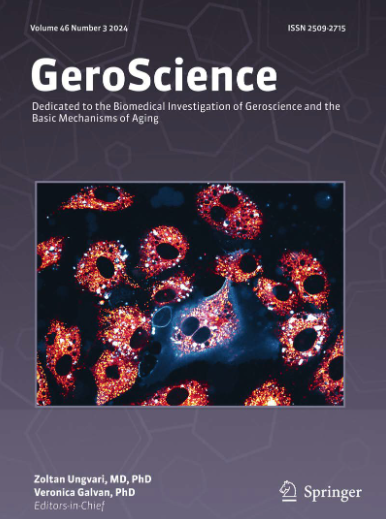Prediction of cognitive decline and Alzheimer's disease conversion by a plasma biomarker panel in non-demented individuals.
IF 5.4
2区 医学
Q1 GERIATRICS & GERONTOLOGY
引用次数: 0
Abstract
Alzheimer's disease (AD) represents a growing global health burden, underscoring the urgent need for reliable diagnostic and prognostic biomarkers. Although several disease-modifying treatments have recently become available, their effects remain limited, as they primarily delay rather than halt disease progression. Thus, the early and accurate identification of individuals at elevated risk for conversion to AD dementia is crucial to maximize the effectiveness of these therapies and to facilitate timely intervention strategies. Baseline plasma concentrations of amyloid beta 40 (Aβ40), amyloid beta 42 (Aβ42), glial fibrillary acidic protein (GFAP), neurofilament light chain (NFL), and tau phosphorylated at residue 181 and 217 (pTau181, pTau217) were quantified in 233 non-demented participants from the Alzheimer's Disease Neuroimaging Initiative (ADNI) and followed for up to 11 years. Covariates included demographic variables and neuropsychological measures. Longitudinal cognitive trajectories were modelled with linear mixed-effects models (LMM), and the risk of progression to AD dementia was evaluated with logistic regression and Cox proportional-hazards analyses. Longitudinally, higher baseline plasma levels of GFAP, NFL, pTau181, and pTau217 independently predicted steeper cognitive decline. Cross-sectional analyses demonstrated significant associations of pTau217, pTau181, and Aβ42 with baseline memory impairment. A logistic regression model incorporating five plasma biomarkers-Aβ42, GFAP, NFL, pTau181, and pTau217-demonstrated robust predictive accuracy for discrimination of future converters to AD dementia. The addition of demographic variables and a baseline memory score further improved model specificity and positive predictive value. These findings support the utility of a concise plasma biomarker panel comprising Aβ42, GFAP, NFL, pTau181, and pTau217 for predicting both longitudinal cognitive deterioration and conversion to AD dementia. This less-invasive blood-based panel could serve as a practical triage tool to enrich clinical trials and facilitate timely therapeutic interventions with emerging disease-modifying treatments.通过血浆生物标志物面板预测非痴呆个体的认知能力下降和阿尔茨海默病转化
阿尔茨海默病(AD)代表着日益增长的全球健康负担,强调了对可靠诊断和预后生物标志物的迫切需求。虽然最近出现了几种改善疾病的治疗方法,但它们的效果仍然有限,因为它们主要是延迟而不是停止疾病进展。因此,早期和准确地识别转化为阿尔茨海默氏症的高风险个体对于最大化这些治疗的有效性和促进及时的干预策略至关重要。在来自阿尔茨海默病神经影像学倡议(ADNI)的233名非痴呆参与者中,对淀粉样蛋白β40 (Aβ40)、淀粉样蛋白β42 (Aβ42)、胶质纤维酸性蛋白(GFAP)、神经丝轻链(NFL)和残基181和217磷酸化的tau (pTau181, pTau217)的基线血浆浓度进行了量化,并进行了长达11年的随访。协变量包括人口统计变量和神经心理学测量。纵向认知轨迹采用线性混合效应模型(LMM)建模,进展为AD痴呆的风险采用logistic回归和Cox比例风险分析进行评估。纵向上,GFAP、NFL、pTau181和pTau217的基线血浆水平较高独立地预测了认知能力的急剧下降。横断面分析显示,pTau217、pTau181和a - β42与基线记忆障碍有显著关联。一个包含5种血浆生物标志物(Aβ42、GFAP、NFL、pTau181和ptau217)的logistic回归模型显示了对未来AD痴呆转化者的预测准确性。人口统计学变量和基线记忆评分的加入进一步提高了模型的特异性和阳性预测值。这些发现支持了包括a - β42、GFAP、NFL、pTau181和pTau217在内的简明血浆生物标志物组在预测纵向认知退化和转化为AD痴呆方面的效用。这种侵入性较低的血液检测可以作为一种实用的分诊工具,丰富临床试验,并通过新兴的疾病改善疗法促进及时的治疗干预。
本文章由计算机程序翻译,如有差异,请以英文原文为准。
求助全文
约1分钟内获得全文
求助全文
来源期刊

GeroScience
Medicine-Complementary and Alternative Medicine
CiteScore
10.50
自引率
5.40%
发文量
182
期刊介绍:
GeroScience is a bi-monthly, international, peer-reviewed journal that publishes articles related to research in the biology of aging and research on biomedical applications that impact aging. The scope of articles to be considered include evolutionary biology, biophysics, genetics, genomics, proteomics, molecular biology, cell biology, biochemistry, endocrinology, immunology, physiology, pharmacology, neuroscience, and psychology.
 求助内容:
求助内容: 应助结果提醒方式:
应助结果提醒方式:


